For years, the SEO world has been tormented by the same question: "How to be number 1 in search results?"
Ranking first on Google for a competitive and valuable keyword became the obsession for SEO professionals. But the first page simply stopped being enough.
And there’s a good reason for that.
Some studies have shown that about 30% of clicks in search results occur on the first position and more than 50% in total are attributed to the first three positions.
What does this mean? In simple language, being in position number 10 could be considered similar to being in position number 100—almost no users will visit your page.
There are many possible theories to explain why this is happening, but these 3 are the most likely:
- The appearance of advertising (AdWords) at the top of the results has greatly reduced the visibility of organic results above-the-fold. This situation has become even more critical starting last year, when Google decided to remove ads in the sidebar in favor of a greater number of paid results in the body of the page.
- The growth of mobile search further limits the visibility of organic results due to the small screen size of smartphones (in spite of tech companies launching increasingly larger phones).
- The change in the behavior of Google users, who expect high-quality results for all their searches and, when they do not get them at first glance, prefer to perform a different search instead of exploring more results from their initial search. This phenomenon is known as "query refinement".
Now, why is it important that you know all this before we get to the topic of this post?
Because featured snippets have the power to drastically change how SEOs think about on-page optimization and rankings.
What are featured snippets?
Featured snippets are “rich” results that are generated by Google from the content of the pages present in the results of a specific search.
As its name indicates, these results are highlighted at the top of the page, occupying what, in the SEO industry, is referred to as "zero position".
This definition may seem complicated, but it’s highly likely you’ve already seen some featured snippets yourself. Here is an example:
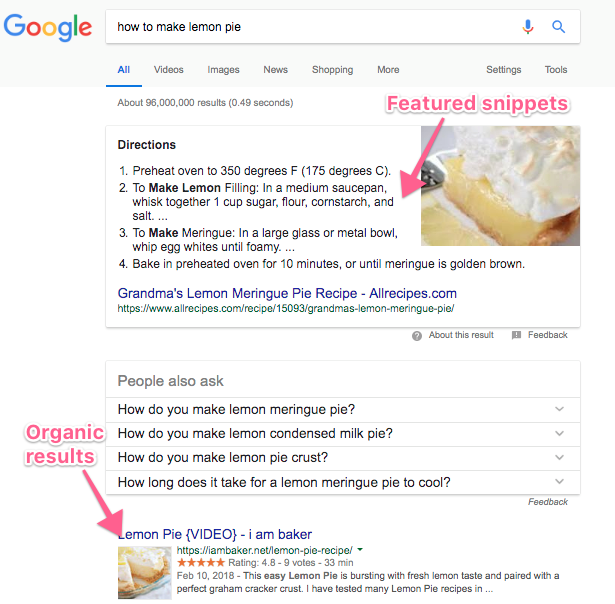
Let us pause to analyze this result for a moment. At first glance, it’s evident why many SEO professionals have diverted their attention from the number 1 position to featured snippets:
- It occupies a higher position than the first organic result, guaranteeing maximum visibility.
- Featured snippets occupy considerably larger “real estate” in the SERPs.
- On many occasions, as in the previous example, they include multimedia results instead of just text.
- They present highly relevant information for the user, instead of just showing the metadata of the page (title, URL and meta description).
- It’s not necessary to be in position number 1 to obtain a featured snippet. In the example above, it’s actually the second organic result that obtained the highlighted position.
- Related to the previous point, the featured snippets allow you to obtain effectively double the visible space on the first page of the results (featured snippet + organic result).
All these factors combined have a massive impact: a greater number of clicks will go to the result obtained by the featured snippet.
In fact, a study conducted by Hubspot found that featured snippets produced an increase in their clickthrough rate (CTR) of up to 114%.
If this is not enough to convince you of the importance of the featured snippets, I doubt that anything will. On the other hand, if you are interested in understanding how featured snippets work, this guide is essential for you.
What are the types of featured snippets?
There are 3 basic types of featured snippets: paragraph, list, and table. There may be slight variations in the composition of each snippet (Google is experimenting more and more frequently with these) but they tend to look roughly the same. Let's examine each one briefly:
1. Paragraph featured snippet
These usually include the definition of a term (example below), although they can also appear in other types of searches.
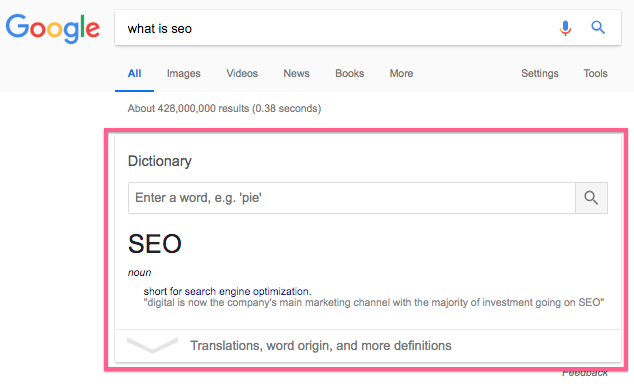
2. List featured snippet
These commonly list elements of a list or steps of a procedure, for example:
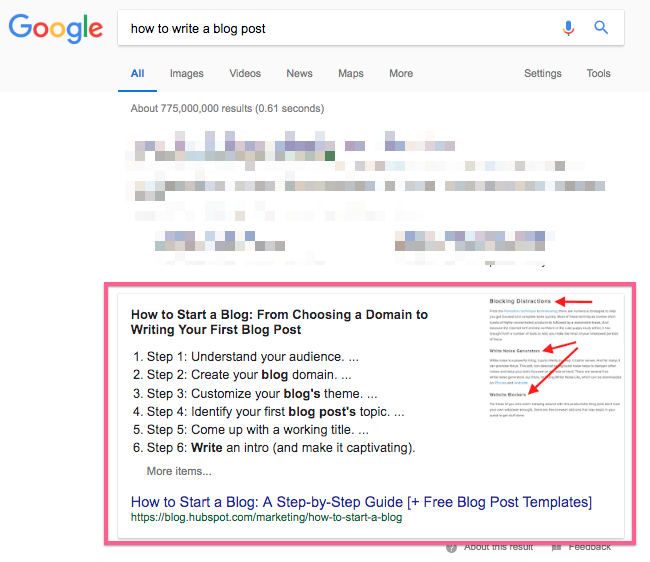
3. Table featured snippet
In most cases, this type of featured snippet is used to present data, for example:
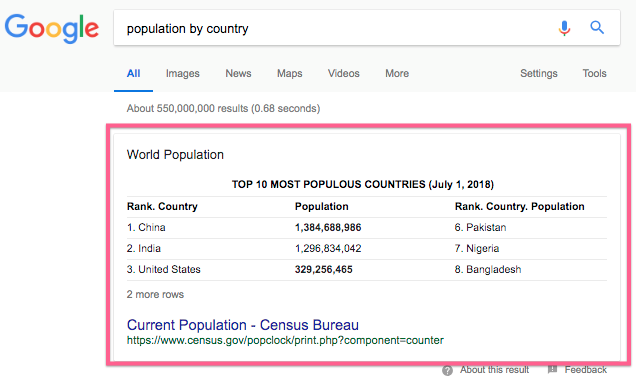
I invite you to do some searches and analyze the results. Understanding the behavior of the featured snippets will be very useful for the next section of this guide.
3 tips and 1 must-have to obtain featured snippets
In order to secure a featured snippet, there are a few things you should do:
Tip # 1: Use a traditional question-answer structure
As you may have already noticed by looking at the examples in this post, the vast majority of search queries that generate featured snippets are formulated as questions.
Google will try to get, from your content, an appropriate response to the user's question. However, remember that Google uses bots and algorithms to analyze the content of your page and, no matter how advanced the software is, it will be difficult to understand answers that are hidden in metaphors or mixed with humor.
Whenever possible, you should try to present a response to the user's question in a traditional way; similar to what you might find in Wikipedia or a dictionary.
Tip # 2: Include the search terms in the subtitles
Although you can’t have complete certainty of their results, a large number of experts in SEO agree that including the keyword inside heading tags (<h2>, <h3>, <h4> and <h5>) can significantly increase the chances of obtaining a featured snippet.
If we combine tips 1 and 2, you will notice that to optimize your content for featured snippets, it is advisable that:
- Your subtitles include questions that users search on Google.
- The text immediately next to the subtitle includes the answer to the question.
Tip # 3: Organize your content in lists and tables
This tip also has to do with the HTML format of your content. In this case, if your content presents a list, procedure, or series of data, you should try to use the appropriate format to organize the text of your page.
That means:
- <ul> for element lists without specific order. For example, a list of ingredients.
- <ol> for lists that follow a certain order. For example, the steps to cook a dessert.
- <table> to sort your data in rows and columns. For example, to list products and their respective prices.
Your must-have to obtain a featured snippet
As I’ve already mentioned, it’s not necessary to rank for the first position to obtain the featured snippet, which generates enough opportunities for new pages with less authority.
However, featured snippets are always generated with the content of the pages in the first 10 positions of the search.
This means that, if you want to obtain “position zero”, you must first position your content on the first page of the results.
Once you have achieved this, you can move to implement improvements in your content to increase your chances of winning the coveted featured snippet space.
1 curious and controversial fact about featured snippets
A group of SEO professionals have criticized Google for the use of content from various sources for the composition of featured snippets:
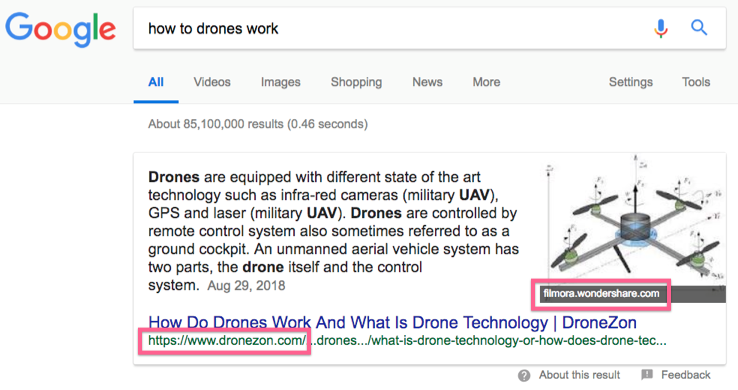
As you can see in the screenshot, the text of the featured snippet belongs to a domain completely different from the origin of the image.
This is very interesting.
The cause of SEO pros’ concern is that practices such as these can result in Google building complex responses with content from different pages in the results, eliminating the need for the user to visit a page to find the information they need.
Because of actions like these, many SEO experts see the future of the profession in being able to create and position content that addresses complex searches, which Google will have a harder time understanding and responding to.
Your turn
After reading this guide you should have the basic knowledge needed to adapt your SEO strategy and take advantage of the opportunity that lies in the featured snippets (and obtain position zero).
Easter egg: If you analyze the structure and composition of this article you will realize that it follows many of the practices that I recommend to optimize your content for featured snippets.
Access the latest business knowledge in Marketing
Get Access





Comments
Join the conversation...